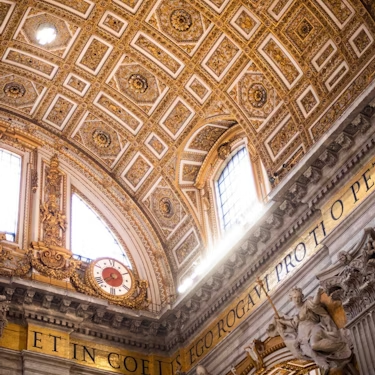More about: 17 Best Palaces in Rome
There is no doubt that the next time you are in the city, you should make sure to include some of these palaces in your itinerary. I guarantee that it will be a very rewarding experience and you will not regret it at all, as visiting the palaces is without a doubt one of the best things to see and do in Rome.
Rome has many incredible palaces, many of which house famous art galleries. However, there are also other palaces that may be the city's best kept secret, but are definitely worth a visit. Without further ado, let me show you the 17 best palaces in Rome and share some tips to help you plan your visit.
1. Villa Borghese

The Villa Borghese, located at Piazzale Scipione Borghese 5, is one of the most iconic palaces known for its extensive public gardens in Rome. The site was built by Cardinal Scipione Borghese, nephew of Pope Paul V. Scipione, who sketched out the ideas, worked with architect Flaminio Ponzio on the design of the palace which began construction in 1633, just outside the city walls.
The villa also houses a magnificent art collection that includes works by famous artists such as Caravaggio, Raphael, Titian and Bernini, among others. There are many things to do in Villa Borghese, for example the place also boasts an impressive gallery composed of paintings from the Roman school and an extensive collection of Egyptian art. This is also, without a doubt, an opportunity to see the top 10 sculptures in Villa Borghese.
2. Palazzo Altemps
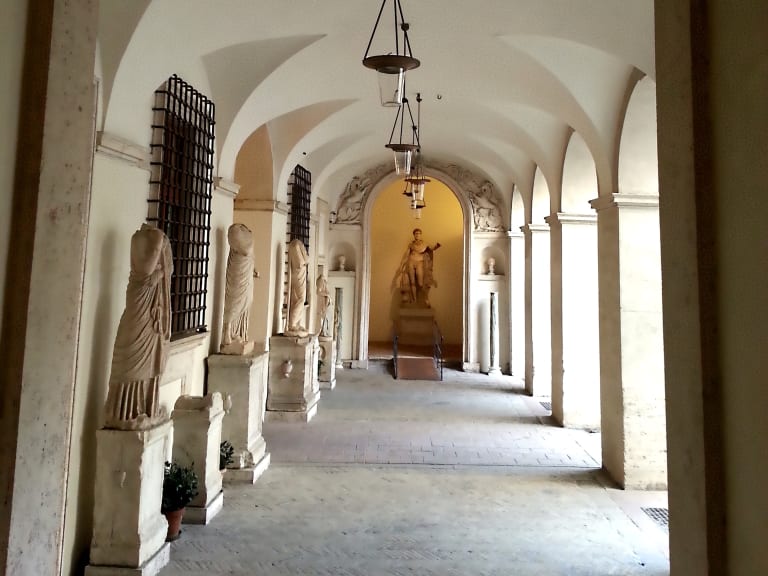
Palazzo Altemps, built in the 15th century, is the seat of the National Museum of Rome and is located in Piazza di Sant'Apollinare 46, very close to Piazza Navona. This place houses an impressive collection of sculptures by Ludovico Ludovisi, nephew of Pope Gregory XV, who throughout his life accumulated a large number of these works of art.
In the Altemps Palace you will find some impressive sculptures, such as the figure of Apollo the Lyric; the Ludovisi Athena, which shows great beauty and strength, and the Throne of Ares, with its majestic design.
If you are a lover of architecture and European pictorial and sculptural art, you can't miss getting your ticket to the Capitoline Museums, one of the most incredible art spaces in the eternal city. Discover its 10 best works of art, some of which are considered true masterpieces.
3. Palazzo Dória Pamphilj
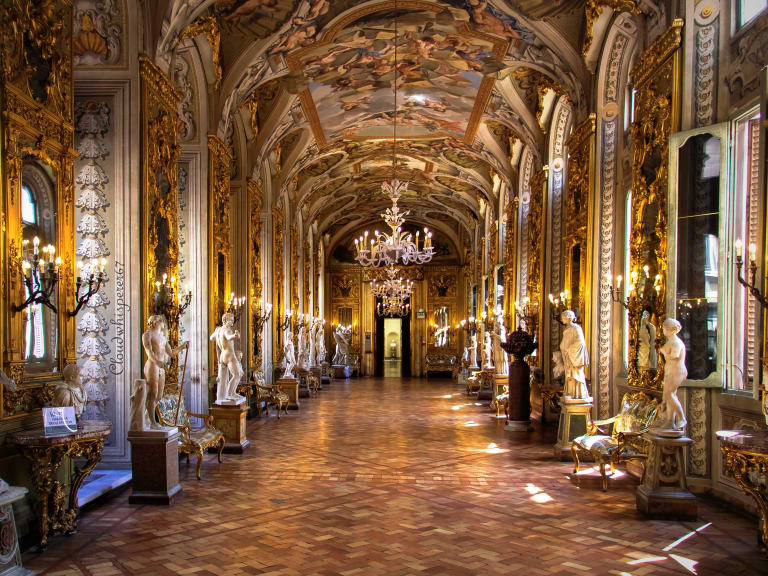
Palazzo Doria Pamphilj, located at Via del Corso 305, near Via della Gatta, is one of the most prominent palaces in Rome that still remains in the hands of an aristocratic family. Since the 16th century, the family has assembled an impressive collection of sculptures, paintings and furniture that are housed in the palace and you can see them if you visit.
This extraordinary collection is based on the inheritance of Pope Innocent X, who left it to his nephew, Camillo Pamphilj. Over the years, the collection has grown and is now considered the largest private art collection in all of Rome.
You can enjoy an impressive collection of antiquities, including the mummified body of the family's patron saint. In addition, there are pieces of medieval and Byzantine art, as well as portraits of famous Renaissance artists such as Bernini, Raphael and Caravaggio. The Palace has more than 1,000 rooms, surpassing in number Buckingham Palace.
4. Villa Giulia

If you are interested in the history and archaeology of the Etruscan civilization, you can't miss Villa Giulia. This place houses the Museo Nazionale Etrusco and is located at Via di Villa Giulia 9, very close to the Borghese Gallery.
This palace was once the summer residence of Pope Julius III and was designed in the 16th century by several artists and architects, including Michelangelo. Once inside, don't miss the sarcophagus of the spouses, considered the best piece in the gallery.
To continue admiring Etruscan art, I recommend combining your visit to Villa Giulia with the National Museum of Tarquinia and the Necropolis of Tarquinia. You will not regret learning more about this fascinating civilization.
5. Palazzo Merulana

Palazzo Merulana, located on Via Merulana, houses more than 90 paintings and sculptures belonging to the modern Roman art of the twentieth century, made by artists as important as Antonietta Raphaël, Dongui, Lucio Fontana or De Chirico.
Each floor of the Palazzo contains different exhibitions, as well as places for rest and relaxation. In addition, the complex hosts temporary exhibitions and different cultural activities, such as talks, literary events, film screenings and even concerts.
On its first floor, the Palazzo Merulana has a beautiful urban garden where you can stroll and relax from the hustle and bustle of Rome.
6. Lateran Palace
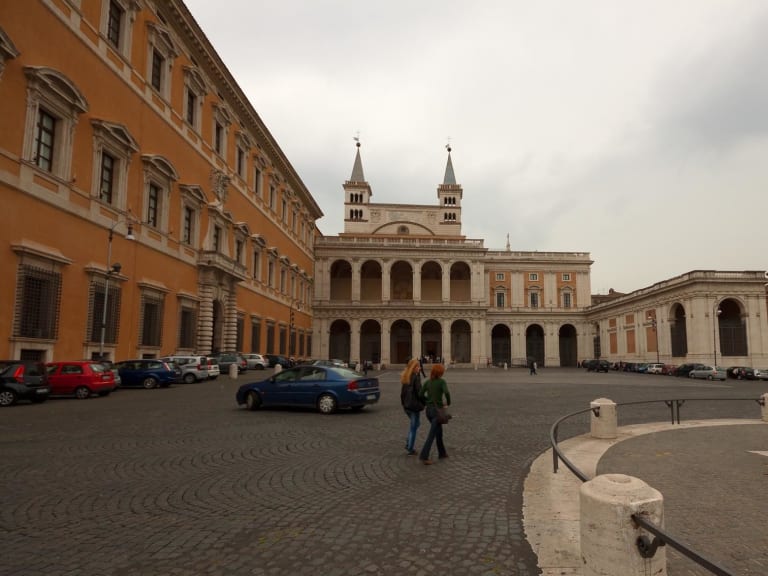
The Lateran Palace or Lateran Palace is located in the historic center of Rome and was once the official residence of the popes.
Inaugurated in 1586, today it is still a building linked to Christian history and art. Thus, in the private chapel, in the ten rooms that make up the papal floor and in the rest of the Palace you can admire countless works of art.
This building not only contains historical facts that go back centuries. In 1929, the Lateran Pacts were signed here, thanks to which the Vatican recognized the legitimacy of the Italian State.
7. Palazzo Corsini
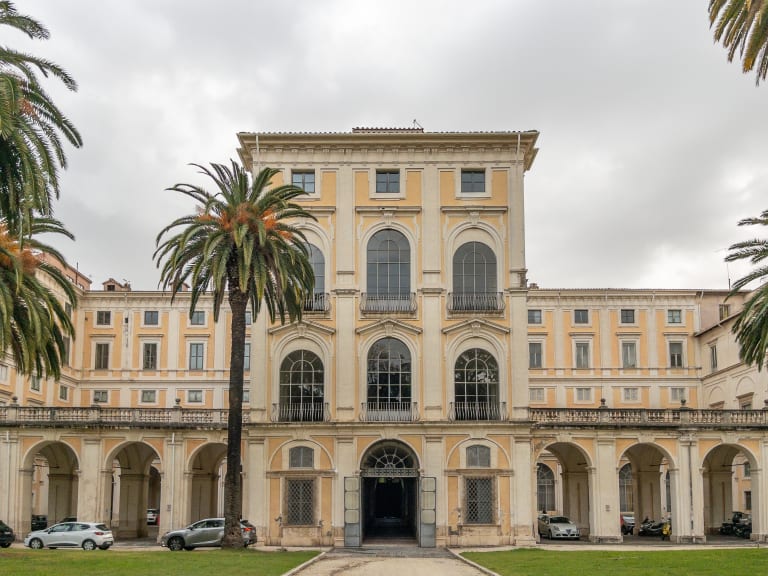
Palazzo Corsini is a must-see destination if you are a lover of art and architecture, and you are passing through Rome. Located exactly in Via della Lungara 10, right in front of the Villa Farnesina, this late Baroque palace was owned by the Corsini family and has been home to illustrious personalities such as fashion designer Elsa Schiaparelli.
In its art gallery you can admire masterpieces by artists such as Caravaggio, Van Dyke, Rubens and Fra Angelico, but undoubtedly the highlight is the impressive painting of John the Baptist by Caravaggio, from 1604. In addition, the palazzo's Library is a marvel in itself, with ceiling frescoes, columns and statues adorning the room.
8. Palazzo Farnese

Palazzo Farnese is one of Rome's most impressive architectural gems. Its exact location is Piazza Farnese 67, in the heart of the historic center of the city, near Campo de Fiori.
The interior of the palace is totally impressive. The highlight is undoubtedly The Loves of the Gods, a fresco on the ceiling that has been recently restored by the artist Annibale Caracci. In addition, the Hall of Hercules, which once housed the original statue of Hercules (now in Naples) and the statues by Giacomo della Porta that adorn a beautiful fireplace, are not to be missed.
Although it is currently the seat of the French Embassy, Palazzo Farnese is open to the public and can be visited on Mondays, Wednesdays and Fridays. Tours, available in English, French and Italian, last 45 minutes and reservations are recommended at least one week in advance.
9. Palazzo Spada

Located in the central Piazza Capo di Ferro, 13, Palazzo Spada is an architectural work originally built for Cardinal Girolamo Recanati Capodiferro in the 16th century, who later became Pope Paul III in 1534.
A particularity of this palace is that, in 1635, Cardinal Bernardino Spada hired the renowned architect Francesco Borromini to improve the design of the garden and make Palazzo Spada appear larger. Borromini achieved this effect by creating an impressive column that tricks the eye and makes the courtyard appear to be 37 meters long, when in fact it is only 8 meters long.
Located near Palazzo Farnese and Campo de' Fiori, Palazzo Spada is a hidden treasure that you should not miss during your visit to Rome. It also has a vast art collection that includes works by artists such as Artemisia Gentileschi, Titian and Tornioli.
10. Palazzo Colonna

Palazzo Colonna is located in Piazza dei Santi Apostoli, 66, a few steps from Piazza Venezia. This majestic building once belonged to the wealthy Colonna family and features a mixture of architectural styles, including Renaissance, Baroque and Roman Rococo elements.
The palace is in excellent condition, with its antique furniture, tapestries and marble floors impeccably maintained. Most impressive, however, is its magnificent art collection, which includes works by masters such as Pinturicchio, Carracci, Guido Reni, Tintoretto, Bronzino, Guercino, Veronese, Vanvitelli, among others. But undoubtedly the most beautiful room in the palace is the Great Hall, lined with beautiful mirrors, sculptures and paintings and a ceiling with frescoes depicting the Battle of Lepanto.
11. Palazzo Pallavicini Rospigliosi

You probably haven't heard of Palazzo Pallavicini Rospigliosi and its Casino dell'Aurora, but if you like to visit off-the-beaten-path places with little tourist traffic, then you should make a note of this place on your Rome itinerary. Located at the highest point of Rome, in Via XXIV Maggio, 43, the casino, part of the Palazzo Pallavicini-Rospigliosi is perfect for enjoying sublime views of the entire eternal city. And if this sounds interesting to you I recommend taking a tour of the best views of Rome.
As you enter this landmark building you can enjoy frescoes by great artists. One of the highlights is the fresco by Guido Reni (1575-1642), known as "L'Aurora", which gives its name to the Casino. In addition, the impressive frescoes "Triumph of Fame" and "The Triumph of Love" by the Roman artist Antonio Tempesta (1555-1630) are also a must-see attraction.
However, it is not only the art that catches the eye in this palace. Its halls feature a variety of marble and travertine moldings, accented with ancient Roman sculptures, making the visit even more impressive.
12. Palazzo Silvestri Rivaldi

Palazzo Silvestri Rivaldi is a real hidden treasure, located very close to the Colosseum. During the 16th century, this palace was abandoned for several years, then underwent a major renovation since 2004, which has finally allowed it to open its doors to the public.
The interior of Palazzo Silvestri Rivaldi houses unique cultural treasures, including frescoes from the school of Raphael and an impressive private collection of over 600 Greek and Roman marble sculptures. Known as the Torlonia Marbles, they date from the 5th century BC to the 4th century AD and belonged to Prince Alessandro Torlonia.
13. Palazzo Barberini

Palazzo Barberini is one of the largest palaces in Rome, with 12,000 square meters and 187 rooms. It is located on Via delle Quattro Fontane 13 and houses the Galleria Nazionale d'Arte Antica.
The palace is beautifully decorated with Renaissance and Baroque paintings and frescoed ceilings. Here you can see Raphael's famous work, La Fornarina, the portrait of the baker's daughter, with whom the artist fell in love while working on the frescoes at Villa Farnesina.
In addition, Palazzo Barberini houses paintings by Caravaggio, Judith Beheading Holofernes, and the self-portrait of Artemisia Gentileschi.
14. Another of Rome's jewels: the Palazzo Della Cancelleria

The Palazzo della Cancelleria, located in Piazza della Cancelleria 1, was built in 1483 by Cardinal Raffaele Riario, nephew of Pope Sixtus IV.
The Pope donated the palace to his cousin, Cardinal Giulio de Medici, who was the vice-chancellor of the Church, hence the name Palazzo della Cancelleria. Here you can enjoy an impressive architecture and an elegant central courtyard, where the atmosphere invites you to relax and spend a moment of tranquility in the heart of Rome. In addition, you can appreciate the collection of ancient Roman sculptures, such as the fountain of the Tritons.
It is said that to build the palace, several sites in Rome were demolished, including the Theater of Pompeii, from which 44 granite columns were taken, and marble from the Colosseum was used. The Hall of the Hundred Days is a must-see, as it contains an impressive work of art: a fresco painted by Giorgio Vasari in just 100 days, by order of Cardinal Farnese. In addition, it is interesting to note that in the 1980s the remains of a 4th century basilica were discovered in the courtyard of the palace.
15. Villa Albani-Torlonia

The Villa Albani-Torlonia is located at Via Salaria 92. It was built between 1747 and 1767 by the architect Carlo Marchionni, who was commissioned by Cardinal Alessandro Albani.
The villa is composed of a series of staircases, frescoes, statues and fountains that reflect the baroque taste of the mid-eighteenth century. Because of its collection of antique artifacts, the villa became quite a spectacle, and many English aristocrats came to know its dazzling halls.
The villa was acquired by the Torlonia family in 1866, who still own it today. Fortunately, the Torlonia family has managed to preserve the villa in its original form, which is still standing with all its original components, so that visitors can admire its grandeur. In fact, the collection of Roman art and items on display here is only surpassed in size by that of the Vatican.
16. Palazzo Patrizi Montoro

The Palazzo Patrizi Montoro, located in the central Piazza di S. Luigi de Francesi, 37. This building is almost hidden between the Pantheon and Piazza Navona, and has been owned by the Patrizi family since 1642.
The interiors of this palace still retain their original furnishings. In particular, the second floor is a treasure trove of antique furniture and artwork. The architectural and interior design features, from the carved stone arches to the tiled floors, are truly impressive.
It is important to note that tours of this private property are only available by appointment. Once inside, the palace's official guide will take you through the history of the place and show you the impressive collection of original paintings, sculptures and furniture.
17. Villa Farnesina

Here is a palace that stands out from the rest. It is the Villa Farnesina, located at Via della Lungara 230, in the Trastevere neighborhood, where there are many things to do.
It was designed by architect Baldasarre Peruzzi and built between 1506 and 1511 for Agostino Chigi, who originally called it Villa Chigi. This place was created to impress wealthy Romans and, with its luxurious decor and beautiful garden, it certainly did.
The Villa Farnesina is a Renaissance palace that houses beautiful paintings by Raphael. The most impressive room is the Loggia of Cupid and Psyche, where Raphael, together with his disciples, created a masterpiece. Other rooms that will leave you amazed are the Hall of Galatea, where you will find Raphael's Triumph of Galatea and the Hall of Perspectives.











